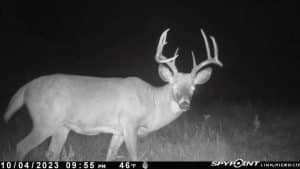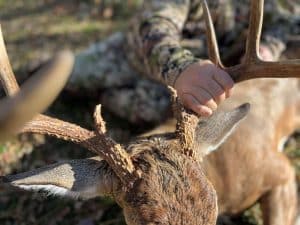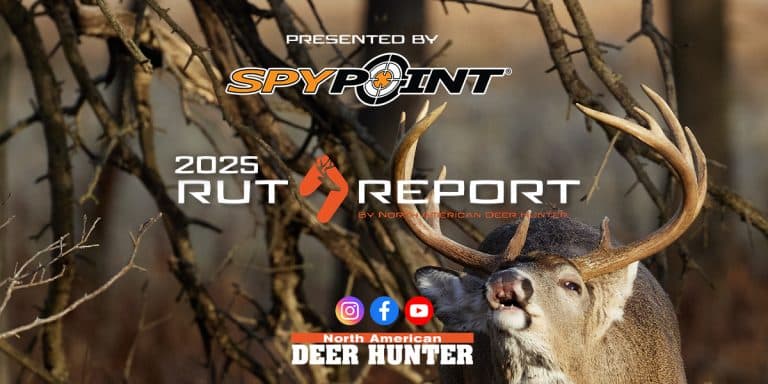1 / 2
 Oh Hello!
Oh Hello! Just a few deer here...
Just a few deer here... Mule Deer on Spypoint
Mule Deer on Spypoint Mega 8
Mega 8 Velvet Bucks
Velvet Bucks Giant Buck!
Giant Buck! It's coming soon!
It's coming soon! Monsters come out at night!
Monsters come out at night! Potential!
Potential! Who likes big 8's?
Who likes big 8's? Shoot or Pass?
Shoot or Pass? Who you looking at?
Who you looking at? Great place to feed for the evening!
Great place to feed for the evening! Cactus Head!
Cactus Head! Get Out of Here!1 / 2
Get Out of Here!1 / 2
Chasing Seeking Phase: October 21-30
The seeking and chasing phases are two of the most exciting (and huntable) windows in the whitetail rut cycle. This is when mature bucks start actively moving, covering ground, and looking for the first receptive does. Bucks will expand from 30 acres of travel to 3,000 seemingly overnight.
- Timing: Oct. 21 – Oct 30
- Behavior:
- Bucks begin intensely pursuing does, but most does aren’t fully in estrus yet.
- You’ll see running, grunting, and chaos as bucks harass does.
- Daylight activity peaks—this is when rutting gets loud and visible and a chase can break out at any moment
- Distance Covered:
- Bucks may run multiple ridges, fields, or sections of timber in a single day.
- They often travel with less caution as hormones take over.
Understanding what’s happening—and how deer use the landscape during these phases—can drastically improve your stand placement and strategy.
Pre-Rut Kicks Off Strong: Nov. 3–10
The first days of November coincide with a waxing moon, reaching full brightness on November 5. That means the moon is 91% visible on November 1 and climbing—a perfect setup for the pre-rut seeking phase.
Expect mature bucks to start stretching their legs, checking scrapes, and cruising for the first receptive does. Evening sits near food sources—corn, beans, clover plots—should produce. If a cold front drops in, even better. Hunt afternoons hard, especially Nov. 1–4.
Peak Rut Activity: Full Moon Week, Nov. 11-22
The full moon hits November 5, and I expect strong daylight activity—especially in the mornings. Contrary to popular belief, I’ve seen some of the best all-day rutting action around the full moon.
Set up deep in the woods along funnels and travel corridors close to doe bedding areas. Bucks will be locked into search mode. You could catch a shooter on his feet at any time—8 a.m., 11 a.m., 2 p.m. Stay in the stand all day if you can hack it. Historically, Nov. 5–12 is when the biggest bucks hit the dirt.
Late Rut Push: Nov. 23-29
As we slide past the last quarter on Nov. 11 and toward the new moon on Nov. 19, rut intensity may taper slightly, but action will still be solid—especially in pressured or big-woods areas. Bucks that didn’t connect early will still be cruising.
Focus on deeper cover, scrapes that are still being hit, and spots near doe bedding. Midday sits can still be productive, particularly 11 a.m. to 3 p.m. Don’t sleep on this window.
When to Hunt (Based on Terrain & Pressure)
- Farm Country / Crop Fields:
- Best Dates: Nov. 1–5
- Focus on afternoons near feed. Light hunting pressure = more daylight movement.
- Ideal Stand: Ridge or staging area 100–200 yards off a cut field.
- Big Woods / Mast & Browsing Areas:
- Best Dates: Nov. 5–12
- Morning hunts near scrapes, bedding areas, and funnels. Stay longer on stand.
- Hunt deeper. Set up off known doe bedding and let the bucks come to you.
Optimal Barometric Pressure Range
- 29.90 to 30.30 inches of mercury (inHg)
- Sweet Spot: ~30.00–30.20 inHg
Within this range, especially when pressure is rising or steady high, deer are often more active during daylight—particularly in the mornings and evenings.
Best Conditions: Rising Pressure After a Front
- After a cold front or storm pushes through and the pressure rises quickly, deer movement tends to spike.
- This rising pressure typically brings cooler, clearer conditions, which also boost movement.
- Hunters often report this 12–24 hour window as one of the most productive times to be in the woods.
Low Pressure (<29.70 inHg)
- When pressure drops rapidly, like before or during a storm or warm front, movement typically slows down, especially for mature bucks.
- Deer may feed or move more just before the storm hits, but often go into “wait it out” mode during extended low-pressure stretches.
Closing Thoughts
This year’s rut window is compact and intense—Nov. 3–10 is your prime time. The full moon lands right on cue to trigger big movement, and the new moon around Nov. 19 could offer a last-chance flurry of rut activity. Keeping a watchful eye on our Spypoint Trail Cameras is key to know when is go time.
As always, pressure is the X-factor. Hunt smart, hunt where the bucks haven’t been bumped, and you’ll up your odds dramatically.
Good luck out there—may 2025 be the year you tag your biggest buck yet.
Rut Report: Mid-October 2025 – Ranges Widened
By mid-October, a major transition is unfolding across the whitetail woods. Bucks that just weeks ago were visible in velvet, feeding in open fields and traveling in bachelor groups, are now vanishing from summer haunts. What hunters are witnessing is not random—it’s The Whitetail Shift, a predictable yet dramatic behavioral change that signals the start of the fall pattern.
This shift isn’t just a change in movement—it’s a complete reset in how bucks relate to food, cover, pressure, and each other. And if you don’t adapt with them, you’ll be left wondering where all the deer have gone.
What’s Causing the Shift?
As September gives way to October, several key triggers push bucks into their fall routines:
- Food sources like soybeans and alfalfa begin to yellow and lose appeal / Corn Becomes a staple food source
- Hunting pressure increases with early bow seasons opening
- Bucks begin making rubs and scrapes seemingly overnight and expand their ranges
- Bachelor groups break up as dominance starts to be established sparring matches turn into full blown territory battles
In response, mature bucks abandon their summer ranges in favor of fall habitat—typically 1–2 miles away. These new core areas offer thicker cover, better wind protection, and fewer human encounters. This move is often misunderstood by hunters who believe bucks have “gone nocturnal.” In reality, they’ve just relocated and are laying low until conditions are right.
Weather Cues and Movement
Cooler temps, shifting winds, and the season’s first frosts all act as natural cues that push deer into their fall mindset. Look for:
- Barometric pressure dips, first cold fronts of the year are coing thru
- Winds changing direction and speed pay attention to thermals and wind speed
- Food plot attractiveness dropping off hunt funnels and doe bedding fringes
As this happens, bucks begin frequenting staging areas near bedding, often in thick cover with high stem count and low visibility. Movement becomes more transitional—deer are shifting between bedding and remaining food sources, setting the stage for the pre-rut.
Tactics to Match the Shift
This time of year demands a shift in your hunting strategy. Here’s how to stay in the game:
🔹 Trail Cameras: If your buck is showing up two hours after dark, he’s likely bedding ¾ mile or more away. Study direction of travel to pinpoint bedding and access routes. Only move in when conditions are perfect.
🔹 Early Rubs: These are territorial, not rut-driven. They show staging zones and indicate where bucks are testing the area. Later rubs will reveal where bucks are spending serious time during the rut.
🔹 Adapt to the Now: Don’t rely on August sightings. Focus on where bucks are going—dense bedding cover, secluded funnels, and edge habitats with nearby food.
🔹 Pressure Matters: Ask yourself three questions:
- Is your food source still attractive (i.e. brassicas, oats, or cereal grains)?
- Are you providing secure, thermal bedding?
- Are you minimizing intrusion with smart wind and entry/exit routes?
🔹 Small Parcel Strategy: You don’t need hundreds of acres to hold bucks. Focus on quiet access, layered food plots, and sanctuaries that never get hunted.
Looking Ahead: Pre-Rut Is Approaching
The stage is being set for rut activity to ramp up quickly. With the rutting moon falling on October 18th and signs of an early rut forming, peak activity is expected from November 4th–17th.
Phase predictions:
- Seeking Phase: Begins around October 25rd
- Chasing Phase: Starts around October 30th
- Tending/Breeding Phase (“Lockdown”): Begins around November 8th-17th
What to Expect for a Synchronized Rut
If three key factors align around November 5th (+/- 3 days), you can expect a powerful, synchronized rut:
- Doe estrogen peaks
- Buck testosterone peaks
- Rutting moon lands near November 5th all happens around the same time
When this trifecta hits, deer activity skyrockets. Bucks will be visible all hours of the day, covering ground, fighting, and breeding as competition peaks.
Final Thoughts
The Whitetail Shift may feel like a lull—but it’s anything but. It’s a signal that bucks are recalibrating for the most active phase of the season. Your trail cameras may cool off briefly, but don’t let it fool you. The real action is just around the corner.
This isn’t the time to get discouraged. It’s time to double down—adjust your cameras, refine your stand locations, and stay mobile. With smart habitat strategy and a clear understanding of shifting patterns, you’ll be ready when that mature buck reappears—on your terms, not his.
Rut Report: Mid-September 2025 – Ranges Widened
As summer fades and crisp mornings settle in, whitetail hunters across the country find themselves entering a pivotal phase of the season. Bucks that just weeks ago stood confidently in velvet, feeding openly in fields, are beginning to vanish from familiar haunts. What you’re witnessing isn’t a mystery or a myth—it’s the annual and dramatic transition known as The Whitetail Shift.
This critical behavioral pivot marks the start of the true fall pattern—and it changes everything you thought you knew about early-season whitetail strategy.
Whitetail Deer Patterns
Throughout the summer, mature bucks stick to a predictable rhythm: bedding in shaded woodlots, feeding in lush agricultural fields, and socializing in bachelor groups. But that phase is quickly ending.
By mid-September, several key changes take place:
- Food sources like soybeans and alfalfa begin to yellow and lose appeal.
- Rubs and Scrapes will start appearing as if overnight
- Social hierarchies are tested.
- Hunting pressure increases as the first Bowseasons kick off
As a result, bucks begin to abandon their summer range—relocating to secure fall habitat that offers dense cover, lower visibility, and minimal disturbance. This shift can be deceptively subtle but often spans 1 to 2 miles or more. It’s the reason many hunters think deer have “gone nocturnal” or “disappeared” in September.
In reality, the deer haven’t vanished. They’ve just moved—and they’re laying low until the timing is right and preparing for the RUT
Weather Cues & Timing
Weather is one of the biggest catalysts for The Shift. Shorter days, cooler temps, and the first few frosts all signal to deer that it’s time to adapt.
By mid-September, these early fall conditions begin to take hold:
- Food plots lose attractiveness.
- Winds shift direction and wind speed
- Barometric pressure dips.
These triggers often correspond with noticeable changes in deer movement. Bucks retreat to bedding thickets—areas with high stem count vegetation, thermal cover, and limited visibility. This is when you should shift your focus to rut staging areas and transition corridors between fall bedding and preferred food sources.
Tips for Mid-September Success
🔹 Use Trail Cams Smarter
- Timing = Distance: If a buck shows 2 hours after legal light, he’s likely bedding ¾ mile or more from your camera location.
- Direction = Intent: Study movement patterns—where deer are coming from or going—to identify bedding areas and travel routes. Only hunt when conditions are perfect.
🔹 Rubs Tell Stories
- Early Rubs (pre-leaf drop): Indicate staging and territory establishment—not yet rut-driven.
- Later Rubs: Show where bucks are spending real time during breeding phases.
🔹 Hunt Habitat, Not History
- Don’t rely on where you saw bucks in August.
- Instead, hunt where they’re headed now—dense bedding, edge cover, and low-pressure sanctuaries with nearby food.
🔹 Ask These 3 Questions:
- Food – Are your plots offering high-carb, fall-attractive forage like brassicas, oats, or cereal grains?
- Cover – Are you offering secluded, thermal bedding with high stem count?
- Pressure – Are you entering stands with wind discipline and minimal intrusion?
🔹 Small Parcel Strategy
You don’t need big acreage to hold mature bucks—just smart design:
- Use layered food plots to pull deer in stages.
- Prioritize quiet entry/exit routes.
- Maintain sanctuary bedding that never gets pressured.
Conclusion
The Whitetail Shift is not a setback—it’s an opportunity.
By mid-September, you’re no longer hunting velvet patterns. You’re playing chess with mature bucks repositioning for the coming rut. Trail cam activity may drop temporarily, but it’s not time to panic. It’s time to pivot.
Understand that bucks are adapting to seasonal pressure and habitat changes. Your job is to do the same. Don’t try to keep bucks year-round—focus on building a property they want to be on when it matters most: October through December.
With the right habitat, strategic trail cam placement (like SpyPoint), and a clear grasp of how and why bucks are shifting, you’ll be in the right place when that elusive giant reappears—just in time for the rut.
Rut Report: Mid-August 2025 – The Annual Whitetail Deer Shift
As summer gives way to fall, whitetail hunters across the country find themselves brimming with anticipation. Velvet-covered bucks fill lush fields, offering a tempting glimpse into the possibilities of the upcoming season. But seasoned hunters know: this visibility is short-lived. A dramatic and annual transition known as The Whitetail Shift is about to take place—changing everything you thought you knew about deer movement and hunting strategy.
Whitetail Deer Patterns
Throughout summer, mature bucks enjoy a comfortable, predictable routine—feeding in open fields, bedding in cool woodlots, and traveling in relaxed bachelor groups. But this behavior is temporary.

Come early fall, everything changes. Food sources like alfalfa and soybeans dry up, hunting pressure begins to mount, and bucks abandon the openness of their summer range. They relocate to their fall range—areas with dense cover (higher stem count bedding like shrubs, conifers, and grasses), reduced visibility, and safety.
Many hunters misinterpret this transition as the “October Lull,” assuming bucks have gone nocturnal. In reality, they’ve simply moved—often 1 to 2 miles away—to more secure fall habitat. The same bucks that vanished in September may reappear briefly during the rut, particularly when searching for unbred does or being displaced by dominant bucks.
Weather
Weather plays a vital role in triggering The Whitetail Shift. As temperatures drop and the first frosts arrive, food plots and natural forages begin to brown and lose attractiveness. This environmental cue, combined with shortening daylight and increasing hunting activity, pushes bucks into thicker, more remote bedding areas.
Pay close attention to weather changes—especially frost, wind shifts, and barometric pressure drops—as these often align with major shifts in deer activity. These moments can indicate when it’s time to start focusing on fall bedding and core rut travel corridors.
Tips
🔹 Use Trail Cams Smarter
Timing = Distance: If a buck shows 2 hours after dark, he may be bedding a half-mile or more away.
Patterns = Purpose: Track directionality on your cameras to identify travel routes and bedding zones.
Rubs Tell Stories:
- Rubs before leaf drop = early season staging
- Rubs after leaf drop = rut activity.
- Late-season rubs indicate bucks spending serious time in that area.
- Focus less on summer visibility and more on fall habitat.
- Target or create dense bedding areas paired with low-pressure access and reliable fall food sources.
- Avoid high-pressure hunting tactics early in the season.
- Use morning sits during the second half of the rut when bucks may be returning to fall bedding areas after chasing.
🔹 Ask These 3 Questions:
- Food – Are your plots built for fall use?
- Cover – Is your property offering thermal, secure bedding?
- Pressure – Are your hunting practices pushing deer off your land?
🔹 Small Parcel? No Problem.
You don’t need 80 acres to attract mature bucks. With smart hunting access, layered food plots, and thick cover, even a modest property can become a Fall Buck Magnet.

Conclusion
The Whitetail Shift is inevitable—but it can work in your favor. Instead of panicking when trail cam activity drops in September, understand it for what it is: a natural transition in deer behavior and habitat use.
Don’t aim to keep bucks all season—aim to have the parcel they want to be on when it matters most: October through December. With the right approach, a solid understanding of deer patterns, and strategic use of SpyPoint trail cameras, you can track the shift, build a smarter plan, and be ready when that prodigal giant returns during the rut.
Rut Report: Mid July 2025 – What Whitetail Deer Are Telling Us Now
Welcome to this month’s North American Deer Hunter Rut Report, your boots-on-the-ground guide to understanding deer movement, nutrition trends, and whitetail behavior as the season approaches. While the rut is still months out, savvy hunters know July is critical for preparing properties, dialing in nutrition plans, and watching bucks bulk up and branch out. In this blog, we aim to provide monthly updates and then as we get closer – weekly updates, on the information we gather from our 34 writers, social media trend, and 70+ SpyPoint Trail Cameras that we have set up throughout the United States and Canada. We will discuss deer patterns, weather watch, our best videos, and tips & tactics for setting yourself up for success, and then focus more on just the hunting aspect once the ribbon is cut and hunting season is upon us.
To stay in touch – subscribe to our newsletter & follow us on North American Deer Hunter and North American Outdoorsman Facebook pages.
Patterning Whitetail Deer Movement & Predictions
-
Bucks remain in bachelor groups and show consistent evening movement patterns, especially around soybean fields, clover plots, and creek edges.
-
Trail camera data indicates high activity during early morning and last light, with mature bucks favoring shaded travel corridors near bedding.
-
With minimal pressure and ample food, deer are predictable—perfect for building intel now that will pay off later this fall.
Prediction for the Week:
Expect deer movement to remain stable and focused around lush, irrigated food sources. Bachelor groups will continue patterning in tight loops. If dry weather hits, expect a shift toward water sources.
Weather Watch: July Heat & Its Effects
-
Hot, humid conditions dominate most regions this week, which often means reduced mid-day activity.
-
Expect heavier browsing at night and dawn as deer avoid high temps.
-
Thunderstorms or unexpected rain? Check mineral sites and soft-edge browse—deer often feed heavily right after rainfall.
Tips: Land Prep, Cameras & Summer Nutrition
Nutrition Focus
-
Bucks are in peak antler growth—up to ¼ inch per day—and require a protein-rich diet (16–20%). Ensure your plots or feeders include high-protein legumes like soybeans or alfalfa.
-
Does nursing fawns need high-energy forage? Supplementing with clover or mineral licks helps meet their lactation demands.
Trail Camera Tips
Check out our top 10 Tips for setting up trail cameras. Some takeaways are below for those who want to keep reading.
-
Focus cameras on entry/exit routes to food sources, not just plot centers.
-
Set cameras at waist height with northern exposure to avoid blown-out images.
-
Use time-lapse mode to cover wide fields in early morning and dusk.
Gear Up Early
-
Now’s the time to inventory trail cam cards, batteries, and straps. To help you get started, we have several lists:
- Best Trail Cameras
- Gun Set Up
- Land Management
- Other
-
Check your early season gear—especially lightweight hunting clothes, boots, and hunting backpacks.
Best Whitetail Deer Hunting Videos of the Week
Catch up on the action and tips from around the country. We post these all the time, follow us on Facebook for more.
▶️ “Summer Scouting with Purpose”
Follow along as we check trail cams and break down movement patterns of bachelor groups in a soybean valley.
▶️ “Setting Up Cameras for Early Season Intel”
Learn how to place cameras for long-term payoff—before bucks go hard-horned and disappear.
▶️ “What’s in Their Belly?”
A wildlife biologist walks through what deer are eating this week—and what that tells us about fall activity.
Whitetail Deer Behavior Breakdown: July Highlights
Antler Growth
-
Bucks are nearing the final stretch of velvet development.
-
Growth may slow toward month’s end as testosterone begins to rise.
-
Larger framed bucks should now be distinguishable on cams.
- Want to understand more about deer antler growth? Check out our antler tine growth timeline.
Fawn Activity
-
Most fawns are 4–8 weeks old and becoming more active.
-
Watch family groups moving at dusk, especially in open clover or native browse fields.
Territory Trends
-
Bucks remain docile, sticking close to preferred food and water.
-
Does and fawns are expanding their range slightly but still close to fawning cover.
-
Now is a great time to identify summer core ranges.
Conclusion: Hunt Now With Your Head, Not Your Bow
We’re still weeks from broadheads flying, but the work you do now—scouting, nutrition planning, camera placement—separates filled tags from missed chances. The rut may be the headline act, but the summer setup is your best chance to learn the deer you’ll be chasing come October.
Stay tuned for next month’s Rut Report, where we’ll dive deeper into territorial shifts, velvet shedding timelines, and August trends. Then, we will be nearing that time where it’s time to update you weekly as we approach and enter hunting season.
We will also keep last year’s reports up so you can see differences and similarities between this year and last year and if there’s any advantage we can gain based on the past.
Per our affiliate disclosure, we may earn revenue from the products available on this page. To learn more about how we test gear, click here.



